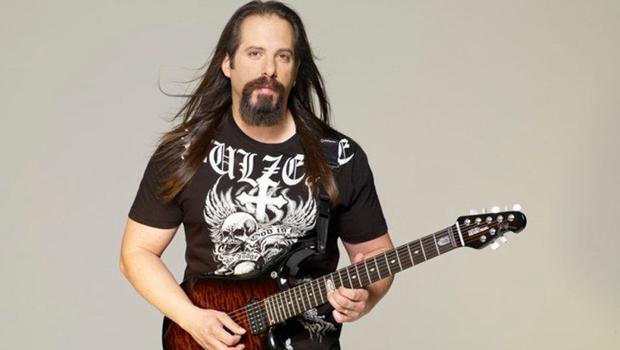Picker's Treat: The Ultimate Picking Lesson with John Petrucci

Whether scorching stages all over the world as a member of prog-metal masters Dream Theater or burning up the fretboard as the frontman in his own power trio, John Petrucci consistently continues to blow minds as one of today’s most brilliant players. In this exclusive lesson, the guitarist unveils the key elements to his phenomenal technique and demonstrates the signature licks to such classic DT songs as “Pull Me Under,” “Sacrificed Sons” and “Metropolis, Pt. 1,” as well as his solo masterpiece, “Damage Control.”
“When it comes to alternate picking,” Petrucci explains, “you can make an analogy to drumming: a drummer uses two hands to play patterns, but might choose to have all of the accents sounded with the right hand. Guitarists use downstrokes and upstrokes to play fast patterns, but doubling up on down- or upstrokes might be essential to the sound of a specific melody. So as a player, you’ve got to sharpen your picking skills as much as you can.”
Petrucci epitomizes the ideal of having one’s picking skills together—just check out such timeless Dream Theater tracks as “Fatal Tragedy” and “Erotomania,” as well as the aforementioned songs. The 39-year-old guitarist has seen his stature rise steadily since 1989 and the release of Dream Theater’s first album, When Dream and Day Unite. By the time of 1994’s Images and Words, Petrucci’s technical skills placed him at the forefront of the metal/prog-rock/shred world. Recent stints as the third guitarist in Joe Satriani and Steve Vai’s G3 guitar summit tours have only garnered Petrucci more acclaim worldwide. “Our fan base is bigger now than ever,” says the guitarist. “It’s incredible how the fans have stuck with the band and have continued to grow in numbers.”
Dream Theater’s latest release, Score, is a two-DVD/three-CD set that includes the bands 20th Anniversary Tour grand finale, recorded at New York’s prestigious Radio City Music Hall—three hours in length, 90 minutes of which features a full orchestra. Other recent releases include the G3: Live in Tokyo DVD and Petrucci’s first solo effort, Suspended Animation.
Petrucci recently took time out to stop by GW headquarters to offer up this exclusive lesson/interview.
Dream Theater’s music ranges from the thrash metal heaviness of Metallica to the technically challenging intensity of complex prog-rock. What bands or guitar players have influenced you the most?
JOHN PETRUCCI: Rush and guitarist Alex Lifeson are among my biggest influences. In fact, if I had to name my favorite band, it would be Rush. One of the essential things I picked up from Alex is how to make the guitar of a trio. This has been useful when playing on my own with my side project.
Get The Pick Newsletter
All the latest guitar news, interviews, lessons, reviews, deals and more, direct to your inbox!
How do you go about making a guitar part sound bigger?
When playing rhythm guitar, one way is to add ninths—or seconds—to the chords, or add the fifth on the bottom of a voicing, and try to use all six strings when playing chords.
Here’s an example [FIGURE 1a]: instead of playing a straight C5 chord, I like to add the suspended second [D, second string/third fret] by barring across all the strings at the third fret. This also enables me to add the low fifth, G, on the bottom of the chord, which fattens up the sound considerably.
Can you site an example of this type of chord in a Dream Theater song?
PETRUCCI For one of the main rhythm guitar parts in “Metropolis, Pt. 1” [FIGURE 2], I use a big E5 voicing played across five strings [bar 2], followed by a Csus2 voicing in the next bar. I also arpeggiate this chord by dragging the pick across all of the strings, moving from low to high, instead of strumming all the strings at once.
This is a big part of my playing style. Anytime I can use open strings in a chord, or add a ninth, I will. For example, I’ll oftentimes play these open sus2 voicings instead of regular power chords [FIGURE 3]. Using open strings or adding the fifth on the bottom of a voicing below the root helps to provide a bigger, richer sound.
GW Are there any other rhythm techniques you picked up from Alex Lifeson?
PETRUCCI A big one is the use of open-string pedal tones within a chord progression. In this example [FIGURE 4], I’m using the open B string as a pedal tone that sustains through the entire chord progression, which helps to create a melodic connection between all of the chords as well as create an ominous kind of feeling. I think these techniques also help to make a rhythm part more interesting, and if you add chorus and delay effects you can end up with a guitar sound that’s as big as a house! Here’s another example wherein all of the chord voicings include the top two open strings [FIGURE 5].
GW A staple of the Dream Theater sound, as well as of your solo work, is the use of airtight guitar/bass octave-unison lines, such as those in the heavy interlude riff in “Sacrificed Sons.”
PETRUCCI That’s another example of the Rush influence. Alex and Geddy [Lee], especially on their early records, played some incred









